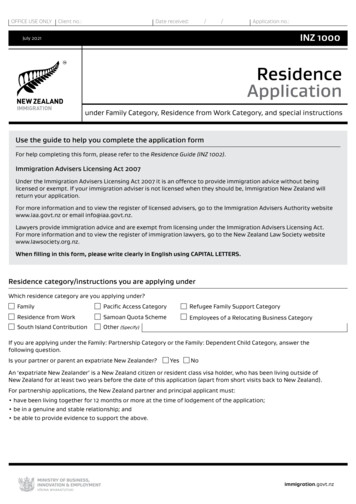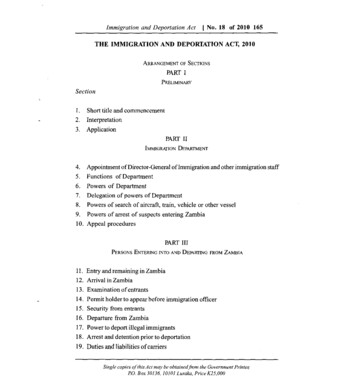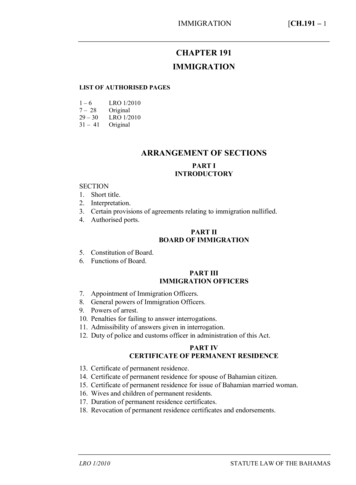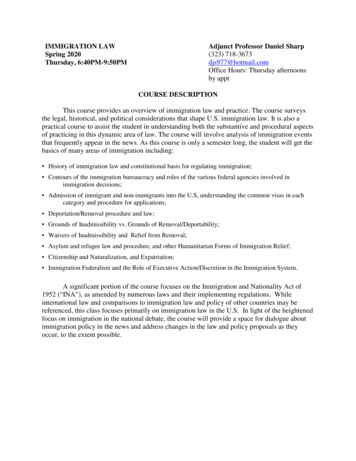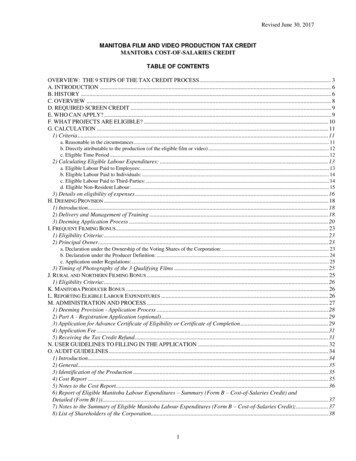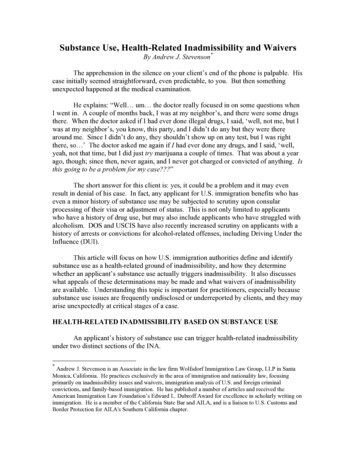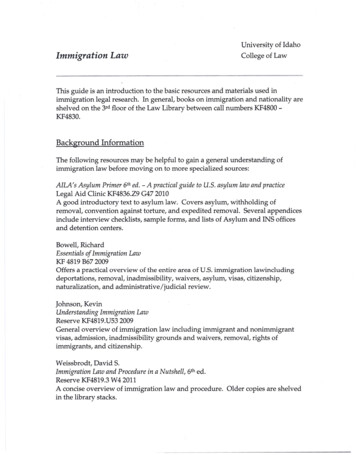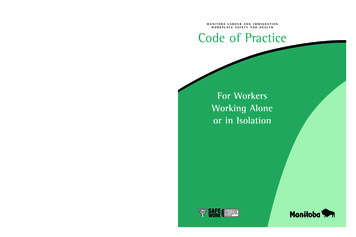
Transcription
Code of Practice Cover12/20/0610:12 AMPage 1MANITOBA LABOUR AND IMMIGRATIONWORKPLACE SAFETY AND HEALTHCode of PracticeFor WorkersWorking Aloneor in Isolation
Code of Practicefor Workers Working Aloneor in IsolationNovember, 2006
TABLE OF CONTENTSIntroduction .3General Information .4Workplace Health and Safety ActEmployer Duties .4Supervisor Duties.6Employee Duties .7Definitions.8Manitoba Regulation 217/2006Working Alone or in Isolation.9Risk Identification .10Safe work procedures.11References.15Code of Practice for Workers WorkingAlone or in Isolation2
INTRODUCTIONThis Code of Practice provides practical guidance on the requirements of ManitobaRegulation 217/2006 Part 9 -- Workers Working Alone or in Isolation -- adopted underThe Workplace Safety and Health Act. This code does not replace either the regulationor The Act.When an employee may be required to work alone or in isolation, there is a needto:1. Spot the hazard: Identify tasks where workers may have to perform work whileworking alone or in isolation.2. Assess the risk: Train workers in identifying and assessing hazards to which theremay be personal exposure.3. Find a safer way: Implement measures to reduce, control, or eliminate hazards andtry using alternative means of performing the work.Employees can safely work alone or in isolation if they make proper hazard/riskassessments and implement safe work practices and procedures.Code of Practice for Workers WorkingAlone or in Isolation3
This code will:1. assist in the recognition of working alone or in isolation situations2. assist in the development of safe work procedures for performing such tasks3. supplement an employer’s regular training program for workers required to workalone or in isolation4. assist members of workplace safety and health committees in identifying and makingrecommendations for hazard evaluation and controlGENERAL INFORMATIONThis Code of Practice does not cover all circumstances under which a worker may berequired to work alone or in isolation. It does not specify monitoring methods requiredfor specific situations.Employers must ensure they have considered and addressed the hazards and risks injobs where workers work alone or in isolation, and that appropriate safe workprocedures have been developed and implemented.The key concepts contained in the regulation for workers working alone or in isolationare:1. The necessity of assessing all jobs requiring employees to work alone or in isolationto determine the risks and reduce the probability of an incident2. The requirement to develop and implement safe work procedures to eliminate orreduce the identified risks to those workers. This includes training workers andproviding help if there is an injury or other incidentTHE WORKPLACE SAFETY AND HEALTH ACTSelected extracts from The Workplace Safety and Health Act, on duties of employers,supervisors and employees in the workplace follow.Employers’ DutiesGeneral duties4(1)Every employer shall in accordance with this Act:(a)ensure, so far as is reasonably practicable, the safety, health and welfare atwork of all workers; andCode of Practice for Workers WorkingAlone or in Isolation4
(b)comply with this Act and regulations.Further duties of employers4(2)Without limiting the generality of an employer's duty under subsection (1), everyemployer shall:(a)provide and maintain a workplace, necessary equipment, systems and toolsthat are safe and without risks to health, so far as is reasonably practicable;(b)provide to all his workers such information, instruction, training, supervisionand facilities to ensure, so far as is reasonably practicable, the safety, healthand welfare at work of all his workers;(c)ensure that all his workers, and particularly his supervisors, foremen,chargehands or similar persons, are acquainted with any safety or healthhazards which may be encountered by the workers in the course of theirservice, and that workers are familiar with the use of all devices orequipment provided for their protection;(d)conduct his undertaking in such a way as to ensure, so far as is reasonablypracticable, that persons who are not in his service are not exposed to risksto their safety or health arising out of, or in connection with activities in hisworkplace;(e)consult and co-operate with the workplace safety and health committeewhere such a committee exists, regarding the duties and matters with whichthat committee is charged under this Act;(f)consult and co-operate with the worker safety and health representativewhere such a representative has been designated, regarding the duties andmatters with which that representative is charged under this Act;(g)co-operate with any other person exercising a duty imposed by this Act, orthe regulations.(h)ensure that all of the employer's workers are supervised by a personwho:(i)is competent because of knowledge, training or experience toensure that work is performed in a safe manner, and(ii)(i)is familiar with this Act and the regulations that apply to the workperformed at the workplace, andif the employer’s workers are working on a construction project that has aprime contractor, advise the prime contractor of the name of thesupervisor of the employer's workers on the project.Code of Practice for Workers WorkingAlone or in Isolation5
Employer as supervisor4(3)For the purposes of clause (2)(h), an employer may supervise his or her workersif he or she satisfies the criteria set out in that clause.Employer's responsibilities for training4(4)Without limiting the generality of clause (2)(b), every employer shall provideinformation, instruction and training to a worker to ensure, so far as is reasonablypracticable, the safety, and health of the worker, before the worker:(a)begins performing a work activity at a workplace;(b)performs a different work activity than the worker was originally trained toperform; or(c)is moved to another area of the workplace or a different workplace thathas different facilities, procedures or hazards.Performing work activity during training4(5)Notwithstanding subsection (4), a worker may perform a work activity while beingtrained if the worker is under the direction of a supervisor or another person whois fully trained and has sufficient experience in performing that work activity toensure that the safety or health of the worker and any other person is not at risk.Wages and benefits during training4(6)A worker is entitled to the same wages and benefits for any time spent in trainingthat he or she would be entitled to had the worker been performing his or herregular work duties during that time.Duties of supervisors4.1Every supervisor shall(a)so far as is reasonably practicable:(i)take all precautions necessary to protect the safety and health of aworker under his or her supervision(ii)ensure that a worker under his or her supervision works in themanner and in accordance with the procedures and measuresrequired by this Act and the regulations(iii)ensure that a worker under his or her supervision uses all devicesand wears all clothing and personal protective equipmentCode of Practice for Workers WorkingAlone or in Isolation6
designated or provided by the employer or required to be used orworn by this Act or the regulations(b)advise a worker under his or her supervision of all known or reasonablyforeseeable risks to safety and health in the area where the worker isinvolved in work(c)co-operate with any other person exercising a duty imposed by this Act orthe regulations(d)comply with this Act and the regulationsGeneral duties of workers5Every worker while at work shall, in accordance with the objects and purposes ofthis Act,(a)take reasonable care to protect his safety and health and the safety andhealth of other persons who may be affected by his acts or omissions atwork(b)at all times, when the nature of his work requires, use all devices and wearall articles of clothing and personal protective equipment designated andprovided for his protection by his employer, or required to be used and wornby him by the regulations(c)consult and co-operate with the workplace safety and health committee,where such a committee exists, regarding the duties and matters with whichthat committee is charged under this Act(d)consult and co-operate with the worker safety and health representative,where such a representative has been designated, regarding the duties andmatters with which that representative is charged under this Act(e)comply with this Act and the regulations(f)co-operate with any other person exercising a duty imposed by this Act orthe regulationsThe entire Act and relevant parts of the regulation should be studied in detail in order togain working knowledge of their requirements.Code of Practice for Workers WorkingAlone or in Isolation7
DEFINITIONSWorking alone means the performance of any work function by a worker who:(a)is the only worker for that employer at that workplace at any time(b)is not directly supervised by the employer, or another person designatedas a supervisor by the employer, at any time"Working in isolation" means working in circumstances where assistance is notreadily available in the event of injury, ill health or emergency.The definition of working alone indicates that the regulation will apply to virtually allworkers who are performing a job function when they are not in the presence of theiremployer, another person in a supervisory capacity (designated by the same employer),or another worker directly associated with the same employer, at the particularworkplace location and during the same time period the working alone job function isbeing performed.The definition of working in isolation refers to those persons whose work sometimes orregularly requires them to be at a worksite that is remote from other workers, dependingon the physical set up of the facility in question, and in circumstances where assistanceis not readily available in the event of injury, ill health or emergency.Many workers may fall into either category. However, in the case of working alone, theymay be in contact with workers associated with a different employer or the generalpublic. Such contact does not rule out the concept that the worker is working alone, andtherefore this situation will require the same particular attention as outlined in theRegulation.Code of Practice for Workers WorkingAlone or in Isolation8
MANITOBA REGULATION (M.R.) 217/2006 PART 9WORKING ALONE OR IN ISOLATIONApplication9.1This part applies to every workplace where employees work alone or in isolation.Risk identification9.2(1) When a worker works alone or in isolation, an employer must identify the risksarising from the conditions and circumstances of the worker's work inconsultation with:(a)(b)(c)the committee at the workplace;the representative at the workplacewhen there is no committee or representative, the workers at theworkplace.9.2(2) An employer must, so far as is reasonably practicable, take steps to eliminate orreduce the identified risks to workers working alone or working in isolation.Safe work procedures9.3(1) An employer must:(a)(b)(c)develop and implement safe work procedures to eliminate or reduce theidentified risks to workers working alone or working in isolation;train workers in the safe work proceduresensure that workers comply with the safe work procedures9.3(2) Safe work procedures must include:(a)(b)the establishment of an effective communication system that consists of:(i)radio communication(ii)telephone or cellular phone communication(iii)any other means that provides effective communication given therisks involvedany of the following:(i)a system of regular contact by the employer with the workerworking alone or in isolationCode of Practice for Workers WorkingAlone or in Isolation9
(c)(ii)limitations on or prohibitions of specified activities(iii)the establishment of training requirementswhere applicable, the provision of emergency supplies for use in travellingor working under conditions of extreme cold or other inclement weatherconditions.9.3(3) An employer must post a copy of the safe work procedures in a conspicuousplace at the workplace.9.3(4) An employer must review and revise the procedures not less than every threeyears or sooner if circumstances at a workplace change in a way that poses arisk to the safety or health of a worker working alone or in isolation.Personal first aid kit for worker working alonePart 5.13 of M.R. 217/2006 states that an employer must ensure a personal first aidkit, that meets the requirements of Schedule B of this part, is provided to a worker whoworks alone and who does not have ready access to a first aid kit required to beprovided under subsection 5.12(1).RISK IDENTIFICATIONAs previously mentioned, subsection 4 (2), clause (b) of The Workplace Safety andHealth Act states that every employer shall "provide to all his workers such information,instruction, training, supervision and facilities to ensure, so far as is reasonablypracticable, the safety, health and welfare at work of all his workers."When workers are involved in working alone or in isolation situations, specialconsideration should be given to the fact that the worker may not be able to secureassistance, in the event of an incident, as readily as when working with a group of coworkers.Within the context of ‘reasonably practicable’, both employers and workers haveresponsibilities and duties to undertake any job function in the safest manner, taking allreasonable care in each circumstance in order to minimize the possibility of an incident.Risk identification is normally referred to as a Job Hazard Analysis (JHA) or Job SafetyAnalysis (JSA). Resource Material regarding job hazard analysis as developed by theCanadian Centre for Occupational Safety and Health (CCOHS) is appended.When assessing the conditions or circumstances under which the worker is required towork alone or in isolation, particular job functions will have inherent hazards associatedwith them that may be deemed as high risk, low risk or combinations of both. TheCode of Practice for Workers WorkingAlone or in Isolation10
degree of risk involved will not eliminate the requirement for developing safe workprocedures to minimize these risks.Examples of work functions that present high risk hazards may include: Entering any confined spaceWorking with:o high energy materials (radioactive, high temperature)o toxic gases, liquids, or solidso cryogenic (low temperature) materials/processeso high pressure systems (high voltage electrical systems)o logging industrieso moving equipment or machinery Working in:o extreme weather conditionso laboratory functions Handling or transferring flammable liquids such as in oil and gas industriesIndustries where the job functions may not be hazardous but the work environmentmay attract criminal victimization (Eg: where cash or goods are handled as in retailstores, taxis, gas stations, etc.)Examples of work functions that present low risk may include: Maintenance (other than on active processing equipment)Security personnel (except in hazardous locations)Janitorial or custodial (except in hazardous locations)Truck drivers or business people in transitOffice workSAFE WORK PROCEDURESThe circumstances or conditions under which employees are required to work alone orin isolation must be assessed. Control methods / safe work procedures must bedeveloped (in writing) and implemented to minimize the identified risks.Code of Practice for Workers WorkingAlone or in Isolation11
For the purpose of this regulation, the consultation process, with the safety and healthcommittee or representative, is integral to the development and implementation of safework procedures and training for employees The Workplace Safety and Health Act requires workplaces in the province of Manitobato establish workplace safety and health committees where there are 20 or moreemployees. Workplaces with 10-19 employees must have a worker safety and healthrepresentative. For further information, refer to The Act, Manitoba Regulation 217/2006Part 3, and the Workplace Safety and Health Division’s Guideline for Safety and HealthCommittees.Under The Workplace Safety and Health Act, employers must consult and co-operatewith the workplace safety and health committee or the worker safety and healthrepresentative. In workplaces where a committee or representative is not required (lessthan 10 employees), the Act requires employers to consult with workers at theworkplace.Written, safe-work procedures must include an effective communication system and away for employees working alone or in isolation to get help if there’s an injury or othermisfortune.The following suggestions may be incorporated as part of the safe work procedures.Depending on the situation, the examples could represent control methods to minimizerisks, ways to get help in an emergency or a combination of both.Second Person or Buddy SystemUsing a buddy system may be part of a safe work procedure. Employees who arerequired to enter a confined space where the risk assessment has identified the spaceto be (or may become) hazardous must have a standby person (buddy) present at theentrance at all times while the employee is in the space. (Please see the WorkplaceSafety and Health Division’s Code of Practice for Confined Space Entry Work fordetailed information on the requirements for confined space entry work.)In all buddy system situations, consideration must be given to the buddy's qualifications.The buddy must be knowledgeable about the activities of the employee he/she isobserving, be properly equipped with emergency equipment, and be capable of puttingpreplanned rescue or emergency operations into effect.With the buddy system, a second person's presence is required at all times. However,where the probability of serious consequence is high, the two employees must not beexposed to the hazard at the same time. The second person should be within sight, butsafely removed from the immediate area.The buddy system may not be practical in some situations. The consultation mustaddress all factors to decide the best approach in developing safe work procedures.Code of Practice for Workers WorkingAlone or in Isolation12
Personal Check by Another PersonIn many instances, checking the worker's well-being can be done through periodic visitsat regular intervals by an individual, such as the employer, another employee orsomeone designated by the employer.The length of time between checks will depend on the identified risks of the job function.As indicated with the buddy system, the person designated to check the employeeworking alone must be knowledgeable about that employee’s activities and must becapable of putting preplanned emergency operations into effect. Contact with thegeneral public (Ex: passers by) is not considered an adequate control method.However depending on the activity, this control method may become part of a safe workprocedure for working in isolation.Periodic Telephone ContactUse of the telephone for communication at regular intervals may be adequate in low risksituations. Telephone numbers for routine calling and emergency situations must beposted prominently.An example could include a night security person’s function at a location which hasbeen determined to have low risk. Security personnel could call in to their dispatchoffices at regular intervals, (Ex: every hour before starting their rounds). The intervalsbetween these contacts would have to be determined by the estimated hazards at theworkplace. Regulating phone calls to specific times during that work activity may reducethe number of false alarms.Protection of employees who do routine jobs will change when that job is performed innon-routine conditions. This includes such things as the absence of other employees inthe workplace or when the job is performed outside of normal working hours for thatemployee. Even for low hazard activities, such as office work, the employee should beinstructed in safe work procedures for working alone.Constant or Intermittent Mechanical or Electrical SurveillanceMechanical or electrical surveillance equipment may be used in a working alone or inisolation situation. The security systems in use at the workplace may be modified tomonitor a particular employee who is working alone or in isolation as well as the statusof the workplace itself.Many workplaces use personal pagers, two-way radios, emergency sounding devices,visual monitoring systems and similar equipment. This equipment is used as part ofeveryday operations. Many workplaces use wireless or hard-wired systems as well.The most important point to consider is the suitability of safety measures and systemsto workers’ needs. For example, if an employee is deaf, visible alarms should beprovided in the workplace.Code of Practice for Workers WorkingAlone or in Isolation13
Central MonitoringSafe work procedures for working alone or in isolation, or for the workplace in general,may include monitoring by a person or system designed for this purpose.When using a central monitoring system to relay an alarm, the following requirementsmust be addressed:1. All federal, provincial and municipal regulations and bylaws must be met.2. The system must be self-monitoring, with line security between the property and thestation to ensure the system is in operating condition at all times and that acompromised line will automatically signal the monitoring agency.3. There must be an emergency power supply that meets applicable federal, provincialor municipal requirements to ensure the system is in operating condition at all times.4. In rural areas, signal-to-station may be via auto or digital dialer.An example of situations using risk reduction policies and procedures are thoseinvolving criminal victimization. Local police services have developed extensiveprograms for business crime prevention. Materials and information are distributed, uponrequest, through their community relations offices.Employees who are directly involved in the (consultation) process for developing safework procedures for workers working alone or in isolation should ensure that theseprocedures contain as much information as possible. These procedures are meant toinstruct both the employee and the supervisor on the appropriate procedures for thatparticular job.Each specific work activity must have particular requirements and procedures in placefor that activity to be done in the safest possible manner. These requirements andprocedures may be a result of company policy or relevant regulations or standards.Safe Work Procedures to be AvailableTo enforce The Workplace Safety and Health Act and Part 9 of Manitoba Regulation217/2006, a safety and health officer may, at any reasonable time, includingcircumstances where the officer believes a dangerous situation may exist, require theemployer to:o produce any documents, books or records for inspection by the safety andhealth officer that relate in any way to the safety and health of employeeso make copies of, or take extracts from these documents, books or recordsEmployers must maintain and post a copy of the safe work procedures in a prominentplace at the workplace.Employers must review and revise the safe work procedures at least every three years,or sooner if circumstances at a workplace change to create risk to the safety or health ofworkers working alone or in isolation.Code of Practice for Workers WorkingAlone or in Isolation14
REFERENCESFor more information on working alone or in isolation:Alberta Human Resources and Employmentwww.whs.gov.ab.caAlberta Community Crime Prevention Association (ACCPA)www.accpa.orgA Sample Policy on Workplace y/printpage.htmWorkers Compensation Board of Prince Edward Islandwww.wcb.pe.caViolence in the Workplace – Prevention .htmlJob Hazard Analysiswww.ccohs.caViolence in the Workplace, Risk Factors and Prevention Strategieswww.cdc.gov/niosh/violcont.htmlNational Association of Convenience Stores (NACS) Websitewww.nacsnet.orgCode of Practice for Workers WorkingAlone or in Isolation15
practicable, the safety, and health of the worker, before the worker: (a) begins performing a work activity at a workplace; (b) performs a different work activity than the worker was originally trained to perform; or (c) is moved to another area of the workplace or a different workplace that has different facilities, procedures or hazards.
